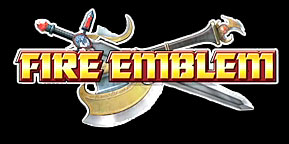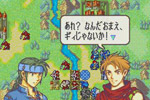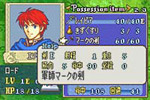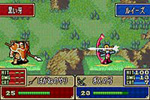
| Platform: Game Boy Advance | Publisher: Nintendo of America |
| Genre: Strategy RPG | Developer: Intelligent Systems | Format: Cartridge | Expected Release: Late 2003 (US) |
It's rather peculiar that one of the most popular strategy RPG series has never made it to North America. After seven installments and a fairly large following in Japan, Nintendo of America finally announced at E3 that Fire Emblem would reach North American shores later this year. Many believe that Sega's Shining Force was the first of the strategy RPG genre in 1992, however it's not so widely known that Nintendo was two years ahead, with the first Fire Emblem released on the Famicom in 1990. Very little of the Intelligent Systems-developed series was heard of in North America, the exceptions being the anime, which lasted two episodes, and the appearance of Roy and Marth in Super Smash Bros. Melee. The first of the series will arrive on the GBA in the form of the seventh Fire Emblem title, known as Rekka no Ken (Blazing Sword) in Japan. Fire Emblem, which is a tentative title and may yet receive a subtitle like its Japanese counterpart, stars two heroes. You begin with Lyndis, the first female in the series to be in the lord class (wouldn't that make her a lady?), who just discovers that she is the heir to the throne of Rikea. However, there is naturally a huge obstacle in her way: her great-uncle. As the story begins, he is at work, attempting to kill off her grandfather, thwart her plans and inherit the throne himself. Later on, we meet Eliwood, who would also be the father of Roy (from the previous GBA Fire Emblem, Fuuin no Ken). The plot doesn't exactly scream originality, but fits very well with the setting and the character development. Fans of Intelligent Systems' other popular strategy, Advance Wars, will have little trouble getting acquainted with Fire Emblem's engine. The player-controlled army and the group of enemies take turns moving across the field, unit by unit. Upon their turns, units can attack, use items, visit villages or shops, rescue, or talk to or trade with adjacent units. Classes and weapons have their advantages and disadvantages of course, the basic system here being 'Sword beats axe, axe beats lance, lance beats sword.' Other examples include pegasus knights being vulnerable to arrows and paladin knights strong against magic spells. There are also supportive classes, such as priests (healers) and calvary (transport) units. The units can also be promoted depending on their level, for example, a social knight (read: guy on horseback who uses swords or spears) can be promoted to a Paladin. So where does the easy part come in? The first ten chapters are Lyn's, and also include (for the first time in a Fire Emblem title) an in-game tutorial. When the game begins, the player is asked to input name, gender, blood type and birth moon. He or she then acts as a 'character' in the game, but no more than a strategist and not someone who actually fights (or even talks for that matter). All kinds of battlefield suggestions are given in these beginning chapters, mainly in the form of strategy tips. Take out the tutorial though, and this Fire Emblem so far offers little challenge with a fairly low number of enemies with limited AI. Keep in mind that the low difficulty may not last through the entire game. As the tutorial is only ten chapters with the demo itself only five, the entire game consists of 20-30 chapters, each usually becoming increasingly more difficult. Even though Fire Emblem is all too visually similar to its predecessor, that doesn't make the game any less impressive or less detailed. One of the more notable qualities about the animation is how characters actually blink and move their mouths during story sequences. The speed at which a unit moves across the field is also determined by the relevance of their speed compared to other classes, which makes armored knights approach their enemies verrrrry slowly. The critical attack animations tend to be rather flashy, often with the attacker moving in various directions all across the screen, complete with motion lines/streaks. Even some key story scenes, including the intro, contain very detailed artwork, even in the background. Those who have played Fuuin no Ken will also recognize some of the score, which remixes a few of its themes, though the ending result doesn't always sound much different than the original. The score blends into the game's setting well, while keeping with a more light-hearted feel than the scores of previous Fire Emblem titles, namely Thracia 776 and Genealogy of Holy War. Perhaps the most delightful piece of music so far has been a remake of the battle theme from the original Fire Emblem, which also played in Super Smash Brothers Melee as stage music. Here, the nostalgic tune plays each time a new unit is recruited by the player. The fact that Intelligent Systems made this game easier for a North American release has drawn a lot of grumbling from the diehard and longtime fans, which is understandable. However, at the same time it's a wise move and a good way to introduce the series to a new audience - a huge new audience called North America. Considering this was Intelligent Systems' goal during development, they cannot be found at fault. For that matter, were Nintendo to bring any more installments in the Fire Emblem series to North America's shores, fans will know what to expect and not need such an in depth tutorial the next time around. Level of difficulty aside, Fire Emblem has a lot of great aspects and there are sure to be strategy RPG fans who will be more than happy with a new title and possibly series. © 2003 Nintendo. All Rights Reserved. |
|




